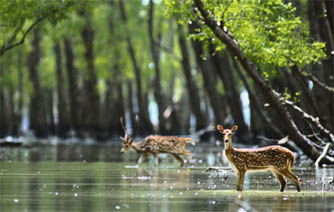DHAKA, June 22, 2020 (BSS) – About 64 percent of people in the country benefit from collecting trees and forest products, according to the first-ever Bangladesh Forest Inventory.
It reveals that the Sundarbans mangrove forest contributes to about 9 percent of the annual income to the surrounding communities.
The inventory also identified 390 tree species and found that landslides or erosion had affected about 16 percent of the country’s forests.
The Ministry for Environment, Forest and Climate Change has already given an official approval to the landmark national inventory developed by the Bangladesh Forest Department with technical expertise from FAO and support from USAID.
The inventory details forest resources and the factors that influence changing demands and use, a FAO press release said today.
It provides a clear picture of the national status of trees and forest resources in Bangladesh – including trees outside forest areas – and their contribution to local livelihoods. For the first time, soil, floral, and socioeconomic data are combined.
This is a new norm for FAO-supported inventories globally and ensures that the contribution of forests to communities is understood and promoted.
Environment, Forest and Climate Change Minister Md Shahab Uddin approved the completed US$ 5.3 million project, which started in 2015 and was funded by the United States Agency for International Development (USAID).
Numerous government, academic and private institutions collaborated to produce the inventory results.
It is planned that users will be able to access the results within a couple of months, made available through the website of the Bangladesh Forest Department.
“The report provides answers to critical questions about the value of forest resources and how communities use these resources,” said Robert D Simpson, FAO Representative in Bangladesh.
“The inventory will also be a valuable tool to understand the impacts of natural disasters such as Cyclone Amphan. FAO congratulates the Ministry of Environment, Forest and Climate Change, as well as the Forest Department, for the successful implementation of this project,” he said.
Simpson also said that FAO supports a proposal to update the inventory every five years as part of a systemic approach to strategic planning of forest resources.
Among many important accomplishments, for the first time the Bangladesh Forest Inventory provides estimates of five carbon pools – above-ground biomass, below-ground biomass, dead wood, litter, and soil organic matter – which act as reservoirs with capacity to both take in and release carbon.
Forests are important carbon pools, offsetting up to 20 percent of global carbon emissions. They continuously exchange carbon dioxide – the principal greenhouse gas – with the atmosphere, due to both natural processes and human action.
Understanding the role of forests in the greenhouse effect requires a better understanding of the carbon cycle at the forest level. For example, forest soils in the inventory were found to have 38 percent higher carbon than other soils.
As populations grow and communities expand, the demand on natural resources increases. Forests remain under growing pressure, increasing the risk of damaging precious ecosystems.
Over the past four decades, FAO has provided technical expertise to support Bangladesh’s transition towards sustainable tree and forest management. The Bangladesh Forest Inventory is a milestone achievement that provides high quality statistical data that will inform a national forestry strategy based on sustainability and community socioeconomic benefits.



